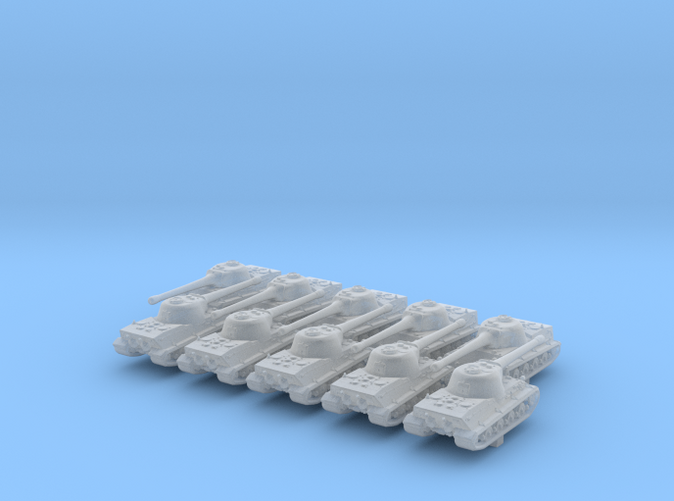1/700 Scale WW2 German Army Pz. Kpfw. VII Löwe Heavy Tank.
Contains 10 highly detailed tanks.
Contains:- 10x Pz. Kpfw. VII Löwe Heavy Tanks
Pz. Kpfw. VII Löwe Heavy Tank
The development of super heavy tank started as early as 1941, when Krupp started the studies of super-heavy Soviet tanks. In November of 1941, it was specified that the new heavy tank was to have 140mm front and 100mm thick side armor. The vehicle was to be operated by 5 men crew - 3 in the turret and 2 in the hull. This new panzer was to have maximum speed of some 44km/h being powered by 1000hp Daimler-Benz marine engine used in Schnellboot (torpedo boat). The main armament was to be mounted in the turret. The weight was to be up to 90 tons.In the early months of 1942, Krupp was ordered to start the process of designing new heavy tank designated PzKpfw VII Lowe (VK7201). Its design was based on previous project by Krupp designated VK7001 (Tiger-Maus) and created in competition with Porsche's designs (including first Maus designs). VK7001 was to be armed with either 150mm Kanone L/37 (or L/40) or 105mm KwK L/70 gun. Lowe was to utilize Tiger II's components in order to simplify the production and service.
Designers planned to build two variants of this streamlined vehicle with rear mounted turret. Light (leichte) variant would have frontal armor protection of 100mm and it would weight 76 tons. Heavy (schwere) variant would have frontal armor protection of 120mm and it would weight 90 tons. Both variants would be armed with 105mm L/70 gun and coaxial machine gun. It is known that 90ton schwere Lowe was to have its turret mounted centrally and in overall design resembled future Tiger II. Variants of Lowe were both to be operated by the crew of five. It was calculated that their maximum speed would range from 23km/h (schwere) to 27km/h (leichte). Adolf Hitler ordered that the design Leichte Lowe was to be dropped in favour of Schwere Lowe. Lion was to be redesigned in order to carry 150mm L/40 or 150mm L/37 (probably 150mm KwK 44 L/38) gun and its frontal armor protection was to be changed to 140mm. In order to improve its performance, 900-1000mm wide tracks were to be used and top speed was to be increased to 30km/h. In late 1942, this project was cancelled in favour of the development of the Maus. During the development of Tiger II, designers planned to build redesigned version of Lowe (as suggested by Oberst Fichtner), which would be armed with 88mm KwK L/71 gun and its frontal armor protection would be 140mm (as planned before). Redesigned Lowe would be able to travel at maximum speed of 35km/h and it would weight 90 tons. It was to be powered by Maybach HL 230 P 30, 12-cylinder engine producing 800hp. Lowe would be 7.74 meters long (with the gun), 3.83 meters wide and 3.08 meters high. Lowe would be operated by the crew of five. It was planned that Lowe would eventually replace Tiger II.
From February to May of 1942, six different designs were considered, all based on the requirements for Lowe. On March 5/6th of 1942, order for heavier tank was placed and project Lowe was stopped in July of 1942. Lowe project never reached the prototype stage but it paved the way for its successor's development - Porsche's Maus.
Cleaning Information
Some part cleanup will be necessary. The 3D printing process uses a waxy substance to support certain part features during the printing process. Although the parts are cleaned by Shapeways, some waxy residue may remain. It can be safely removed with water and a mild aqueous detergent like "Simple Green" using an old, soft toothbrush, Q-tips or pipe cleaners. During the printing process, liquid resin is cured by ultraviolet light. Microscopic bits of resin may remain uncured.
Let your parts sit in direct sunlight for a few hours to fully cure the resin.
Water-based acrylic paints meant for plastics is strongly recommended. Other paints, especially enamels, may not cure on Frosted Detail 3D-printed plastics.
Use dedicated model sprue cutters to remove parts to minimise the risk of damage to parts.
Please take a look at my other items.
Painting tips and preparation
